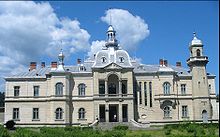Comăneşti
|
Comăneşti Kománfalva |
||||
|
||||
| Basic data | ||||
|---|---|---|---|---|
| State : |
|
|||
| Historical region : | West Moldova | |||
| Circle : | Bacau | |||
| Coordinates : | 46 ° 25 ' N , 26 ° 27' E | |||
| Time zone : | EET ( UTC +2) | |||
| Height : | 400 m | |||
| Area : | 63.86 km² | |||
| Residents : | 19,568 (October 20, 2011) | |||
| Population density : | 306 inhabitants per km² | |||
| Postal code : | 605200 | |||
| Telephone code : | (+40) 02 34 | |||
| License plate : | BC | |||
| Structure and administration (as of 2016) | ||||
| Community type : | city | |||
| Structure : | Comăneşti, Podei , Vermeşti | |||
| Mayor : | Viorel Miron ( PNL ) | |||
| Postal address : | Ciobănuș street, no. 2 loc. Comăneşti, jud. Bacau, RO-605200 |
|||
| Website : | ||||
| Others | ||||
| City Festival : | first week of August | |||
Comăneşti ( Hungarian Kománfalva ) is a city in Bacău County in the historical Moldova region in Romania .
location
Comăneşti is located on the Trotuş river on the eastern edge of the Carpathian Mountains in a valley basin named after the city ( Depresiunea Comăneşti ), between the Tarcău mountains in the northwest, Gosman in the north, Berzunt in the east and Ciuc in the southwest. The district capital Bacău is located about 60 kilometers northeast of Comăneşti.
history
The Comăneşti region has been inhabited since the Neolithic . The village was first mentioned in documents in 1409 under the rule of the Moldavian prince Alexandru cel Bun .
From the 17th to the middle of the 20th century, the noble family of Ghica played an important role in the place, who provided several princes of Moldavia and Wallachia and who owned a castle in Comăneşti.
The proximity to an important Carpathian crossing ( Pasul Ghimeş , 1155 m) established a special strategic importance of the place. Mining played an important role in the 19th and 20th centuries ; In 2005 the last coal mine was closed. Since then, forestry and the wood processing industry have been the most important branches of the economy.
1952 Comăneşti received city status.
population
In the 2002 census, 23,679 people lived in Comăneşti, of whom 23,166 were Romanians , 395 Roma , 69 Hungarians , nine Germans , three Italians , two Russians , two Greeks , two Poles , one Chinese and 30 were registered without ethnicity.
traffic
Comăneşti has a station for passenger traffic on the Sfântu Gheorghe – Siculeni – Adjud railway, where express trains also stop. There are also good bus connections to the district capital Bacau. The national road ( Drum național ) DN 12A, which connects Miercurea Ciuc in Harghita County with Oneşti , runs through the city .
Attractions
In addition to the scenic surroundings, the Ghica Palace is the main tourist attraction.
Born in Comăneşti
- Ilie Verdeț (1925–2001), communist politician
- Anca Grigoraș (* 1957), artistic gymnast
- Ionela Loaieș (* 1979), artistic gymnast
Web links
Individual evidence
- ↑ 2011 census in Romania ( MS Excel ; 1.3 MB)
- ↑ Portalul Primariilor Judeţului Bacău, accessed on November 23, 2008 ( Memento of the original from January 26, 2016 in the Internet Archive ) Info: The archive link was inserted automatically and has not yet been checked. Please check the original and archive link according to the instructions and then remove this notice.
- ↑ 2002 census, accessed November 23, 2008



